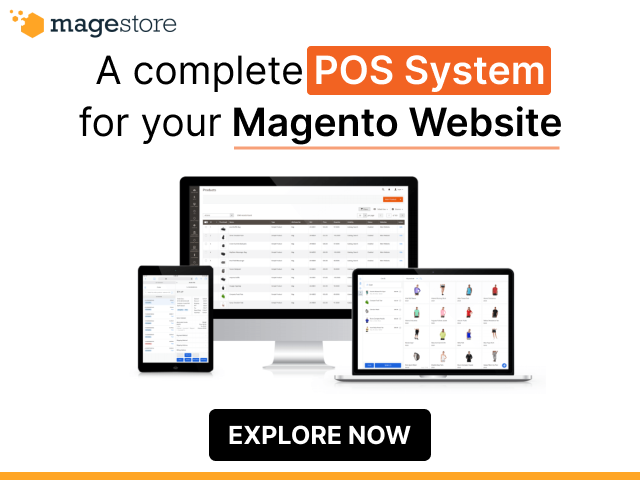Selecting the right eCommerce platform is crucial since it’s the backbone of your eCommerce business success.
Whereas Magento will be ideal for large enterprises due to its advanced features, the installation, operation, and maintenance require a fairly high budget and a masterful development team. Meanwhile, PrestaShop offers more for small businesses, allowing them to get started quicker with basic features and low capital.
Now, let’s go through some Magento vs PrestaShop features and reviews, and head to the final section to decide which fits your business needs and future goals most.
Overview of 2 top eCommerce platforms
What is Magento?
Magento is a PHP-based open source eCommerce platform initially introduced in 2008. Due to its flexible customization and extensive functions, you can create your online store from scratch and scale seamlessly later. In 2018, Adobe, a leading company in multimedia software, acquired Magento and integrated it into its ecosystem to offer a full suite of digital solutions for businesses.
Currently, there are three Magento editions for various business needs, as listed below:
- Magento Open Source: The free codebase version offering standard eCommerce functionalities for small to mid-sized businesses
- Adobe Commerce: Paid and advanced version of Magento Open Source, suitable for enterprises
- Adobe Commerce Cloud: Cloud version of Adobe Commerce on AWS or Microsoft Azure’s cloud hosting
The latest Magento version is Magento 2.4.8 beta version, released on October 8, 2024.
You might like: The ultimate guide to launch a Magento store from scratch.
Let’s take a glimpse at some of the interesting stats that speak for themselves:
- More than 120,900 websites are running on Magento, with many iconic global brands like Coca-Cola, Nike, and Asus.
- Magento’s market share accounts for about 2.06%, ranking as the 3rd most popular eCommerce platform among the top 1 million websites across the globe.
- There are over $100 billion worth of goods processed through Magento-powered eCommerce websites annually.

What is PrestaShop?
Like Magento, PrestaShop is also an open source eCommerce platform based on PHP. Since 2007, this free platform has been supporting thousands of merchants in developing and managing their online stores. Its intuitive interface allows you to create an online store in a few steps. Once your business grows, you can invest in addon features and specific services for greater efficiency.
The most recent versions of PrestaShop include:
- PrestaShop 1.7: Launched in 2016, this version updated the admin panel with back office features like customer, product, and order management.
- PrestaShop 8: In 2022, this focused on performance, security, and developer experience.
Among the most trusted eCommerce solutions for store owners in the globe, PrestaShop has achieved many milestones:
- There are 229,732 live PrestaShop websites with great brands, such as JBL Second Chance, McDonald’s France, and El Pais.
- PrestaShop holds approximately 0.27% of the market share, making it the 5th most widely used eCommerce platform among the top 1 million websites.
- It holds a strong presence in Europe, with around 14.1% of its stores in France, followed by significant footprints in Spain, Poland, and Italy.

Magento vs PrestaShop: A brief comparison of key features
Built-in features | PrestaShop | Magento Open Source | Adobe Commerce |
Open source | ✔︎ | ✔︎ | ✔︎ |
Hosting included | ✘ | ✘ | ✘ |
Integrated payment gateway (PayPal) | ✔︎ Available on PrestaShop Checkout | ✔︎ | ✔︎ |
Payment methods | |||
| ✔︎ | ✔︎ | ✔︎ |
| ✔︎ | ✔︎ | ✔︎ |
| ✔︎ | ✔︎ | ✔︎ |
| ✔︎ Available on PrestaShop Checkout | ✔︎ | ✔︎ |
| ✔︎ Available on PrestaShop Checkout | ✔︎ | ✔︎ |
| ✘ | ✔︎ | ✔︎ |
| ✔︎ | ✔︎ | ✔︎ |
| ✔︎ | ✔︎ | ✔︎ |
| ✘ | ✔︎ | ✔︎ |
| ✘ | ✔︎ | ✔︎ |
| ✘ | ✘ | ✔︎ |
Promotions and pricing | ✔︎ | ✔︎ | ✔︎ |
SEO tools | ✔︎ | ✔︎ | ✔︎ |
Marketing | ✔︎ | ✘ | ✔︎ |
Themes and design | ✔︎ | ✔︎ | ✔︎ |
Product and catalog management | ✔︎ | ✔︎ | ✔︎ |
Order management | ✔︎ | ✔︎ | ✔︎ |
Purchase order management | ✘ | ✔︎ | ✔︎ |
Inventory management | ✔︎ | ✔︎ | ✔︎ |
Shipping | ✔︎ | ✔︎ | ✔︎ |
Customer accounts | ✔︎ | ✔︎ | ✔︎ |
Customer service | ✔︎ | ✔︎ | ✔︎ |
Customer loyalty | ✘ | ✘ | ✔︎ |
Analytics and reporting | ✔︎ | ✔︎ | ✔︎ |
Global selling support | ✔︎ | ✔︎ | ✔︎ |
Multi-site management | ✔︎ | ✔︎ | ✔︎ |
Multi-store management | ✔︎ | ✔︎ | ✔︎ |
Multi-language support | ✔︎ | ✔︎ | ✔︎ |
App marketplace | ✔︎ | ✔︎ | ✔︎ |
B2B functionality | ✔︎ limited | ✘ | ✔︎ |
Support and service | ✘ | ✘ | ✔︎ |
Mobile commerce | ✘ | ✔︎ | ✔︎ |
Third-party integrations | ✔︎ | ✔︎ | ✔︎ |
Scalability | ✔︎ | ✔︎ | ✔︎ |
Security | ✔︎ | ✔︎ | ✔︎ |
Magento vs PrestaShop: A detailed breakdown of 16 factors
Both platforms grasp essential functionalities to launch a successful online business. While Magento holds its position as an eCommerce giant with sophisticated options, PrestaShop stands out for its ease of use and developer-friendly environment. Keep reading for an in-depth Prestashop vs Magento comparison.
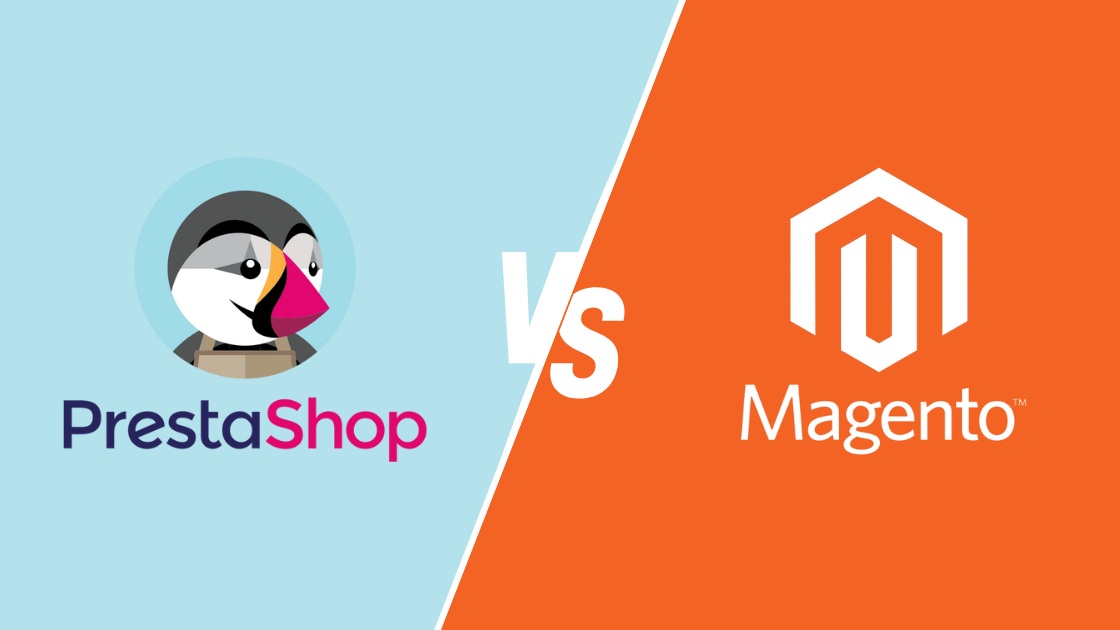
Ease of use
In terms of the learning curve, Magento may overwhelm you with extensive documentation and technical knowledge right from the setup stage. It requires a significant amount of time to deal with system requirements, database creation, and configuration. Thus, finding external help from development experts or agencies will be a good choice.
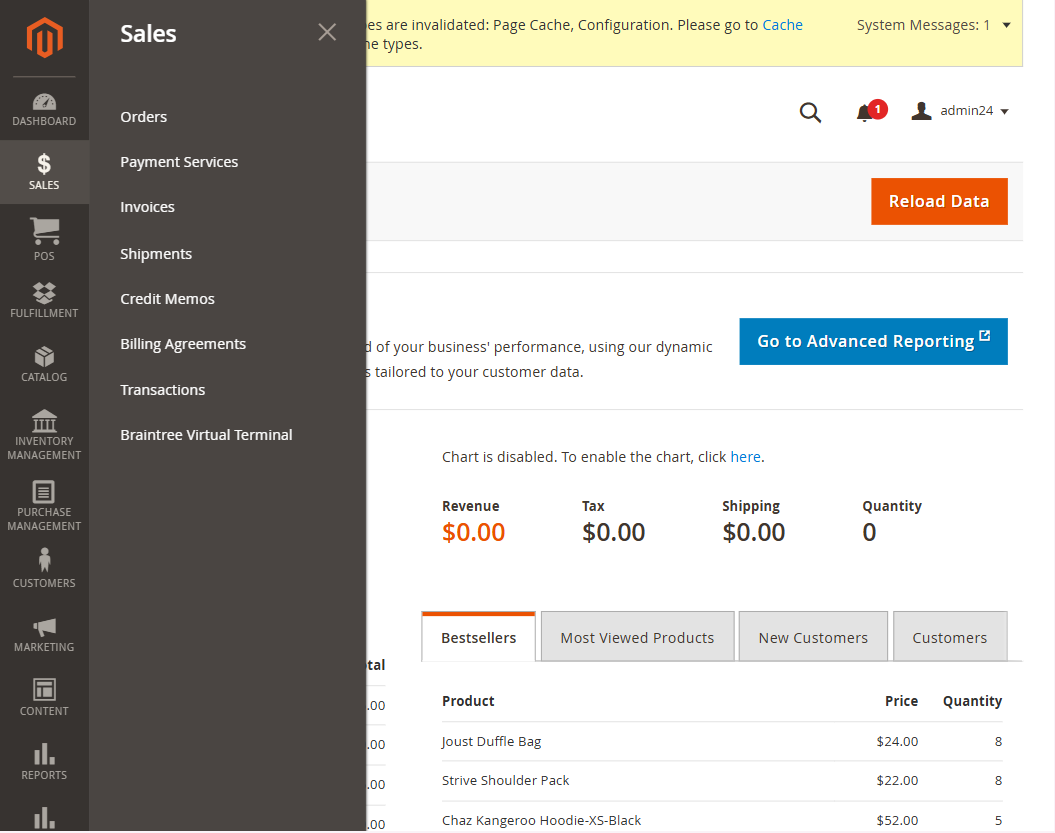
In contrast, PrestaShop offers a more straightforward and beginner-friendly installation process. The Help Center provides an official step-by-step guide for servers and local environments, so even users with minimal programming skills can quickly get started.
Moreover, PrestaShop has received positive feedback for a well-organized and intuitive backend dashboard with a clear menu of products, categories, brands, and suppliers. Nevertheless, new users might find the powerful Magento admin interface complex and time-consuming to understand the structure.
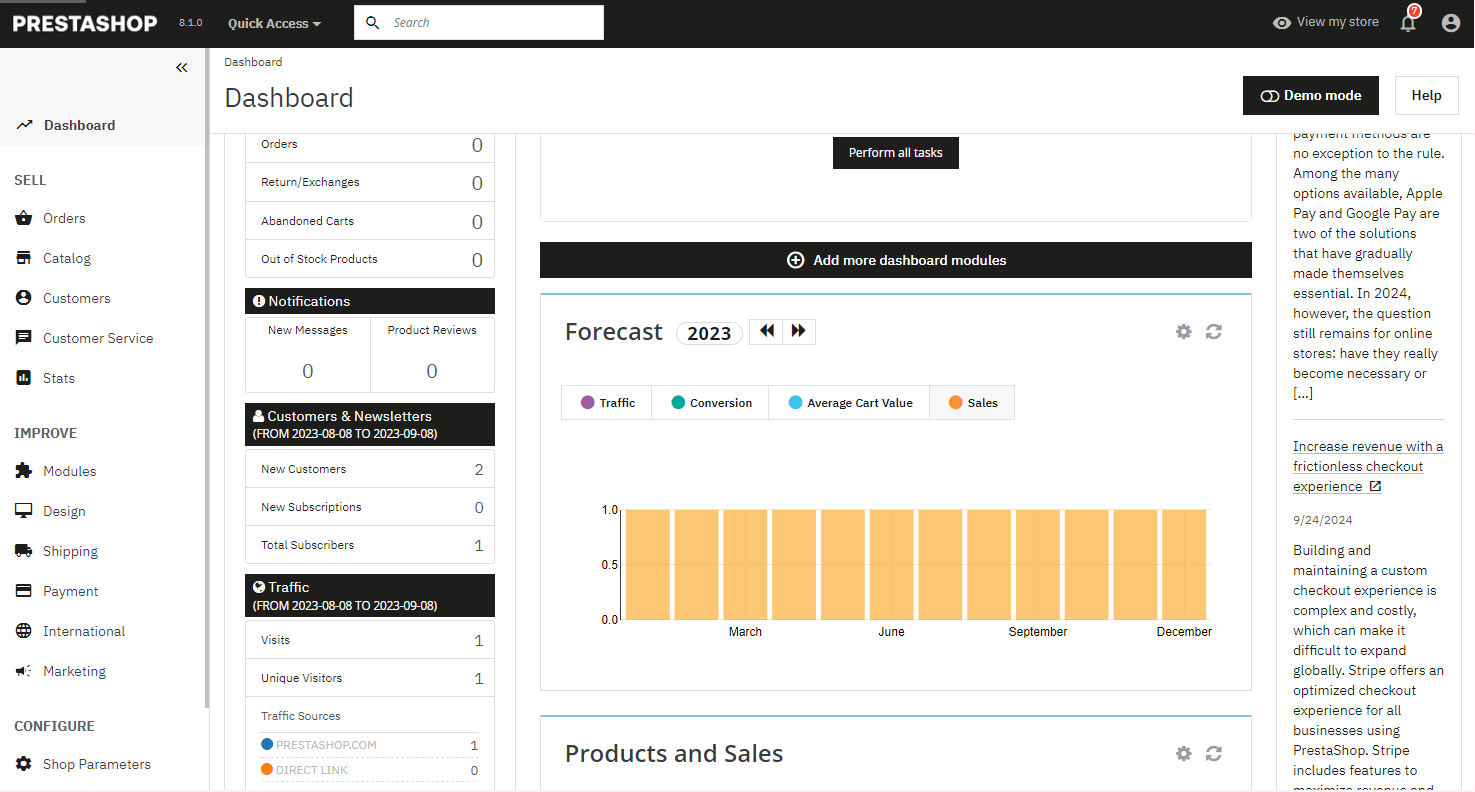
Winner: PrestaShop.
Hosting
PrestaShop, Magento Open Source, and Adobe Commerce all require you to find a hosting provider to set up, manage, and maintain on your server.
When it comes to PrestaShop, the platform offers an official hosting solution starting at €275 per month. However, if you want to save some money, you can explore more affordable options through its partners like IONOS and Hostinger.
Regarding Magento, users must carefully select a reliable third party for hosting based on their needs and specific criteria. Alternatively, for those who prefer a comprehensive solution, Adobe Commerce Cloud delivers one neat package covering the platform and cloud-hosted infrastructure. However, it does come with a significantly higher investment.
All things considered, while Magento leaves it up to users to sort out their own third-party services, PrestaShop takes a more merchant-friendly route, giving flexibility with both its official hosting and partner options.
Learn more about 15 best Magento hosting providers in 2025 (Updated).
Winner: PrestaShop.
Payment
In similarity, both platforms enable you to process credit card transactions on your storefront via PayPal gateway without redirecting customers to external sites. They also offer a treasure trove of payment options, with many available for free.
However, while Magento provides native integration with PayPal and more payment methods by default, PrestaShop requires extra addons from the app marketplace to expand payment options. Let’s discuss this in more detail.
Magento’s online payment methods include:
- Credit cards
- Debit cards
- Bank transfer
- E-wallets: Google Pay, Apple Pay, and Venmo
- Pay later
- Purchase orders
- Zero subtotal checkout
- Payments on account (for Adobe Commerce)
In case you want to cater payment options to specific countries or to set minimum and maximum order limits, you can directly configure the settings from the admin panel.
While PrestaShop doesn’t support integrated payment gateways right on the admin panel, its outstanding online payment solution lies in the PrestaShop Checkout module with the following options:
- Credit cards
- Debit cards
- Bank transfer
- PayPal
- E-wallets: Google Pay and Apple Pay
- Local payment options, such as iDeal and Bancontact
In the PrestaShop backend, you can also leverage the payment preferences for currency, group, country, and carrier restrictions.
Winner: Magento.
Security
This is a top priority for any eCommerce platform. Thankfully, the open source nature of Magento and PrestaShop means more eyes are on the code to detect problems. The core development teams then address these in updates, or community developers can step in to proactively fix issues. Besides, users can integrate their online stores with third-party plugins to follow the best practices for extra protection.
Magento keeps getting its name on the score for robust security with updates released every two months. It also plans a clear schedule for new versions and patches, ensuring any gaps are quickly filled.
Key security features in Magento include:
- Use a standalone installer with prerequisite checks for smooth code updates
- Ensure platform security through regular scanning, penetration testing, and bug bounty programs
- Notify security alerts via the Magento Security Center and mailing list
- Simplify PCI compliance qualification by providing integrated payment gateways and a pre-certified infrastructure (Adobe Commerce)
- Protect data using encryption and hashing (Adobe Commerce)
- Ensure password policies and a secure login process (Adobe Commerce)
Meanwhile, PrestaShop releases new versions and patches on a regular basis. It also encourages the community to report vulnerabilities in the Marketplace modules and work with YesWeHack for a public bug bounty program. Moreover, the built-in Official GDPR Compliance module helps your store meet privacy standards and allows customers to manage personal data easily. However, the core software itself does not inherently handle PCI compliance requirements. In other words, the responsibility falls on merchants, server administrators, and payment gateway providers.
Winner: Magento.
Performance and scalability
Wondering how your business will hold up when facing peak seasons or rapid growth? Considering a platform’s performance and scalability to stay ahead of the competition.
Although Magento Open Source does a solid job handling high traffic and sizable catalogs, medium-to-large-sized enterprises with heavy daily order volumes can consider Adobe Commerce for an all-round solution.
- Varnish page caching and multi-tier configurations
- Hole punching and Edge Side Includes (ESI) for non-cacheable elements
- Faster indexing and incremental index updates
- File compression as well as first-page JS and CSS caching for faster loading
- Faster Admin rendering for management
- Media file storage on a separate server or CDN
- Order archiving
- Magento Performance Toolkit for speed optimization
- Asynchronous task processing with Rabbit MQ
- Configuration management and pipeline deployment to minimize downtime
- MySQL Cluster support for database scalability
- Master-slave database architecture
- Enable large teams of Admin users
PrestaShop is also strong and scalable, but still falls short compared to Magento’s capabilities.
- Smarty cache system that stores pre-rendered pages for faster loading times
- CSS and JS file compression for page loading optimization
- Simple database design and compact cache system tailored for catalogs with fewer than 10,000 SKUs
- Varnish and Elasticsearch are available for installations when your business requires higher site performance.
Winner: Magento.
Customization
The open source nature of both platforms gives the flexibility to adjust your store to match unique needs. Whether it’s customizing themes or features, there’s a lot you can do to personalize the look and feel of your online store.
Although Magento offers deeper customizations, it requires significant time investment and technical expertise to tailor the source code.
Winner: It’s a draw.
Integration
One of the main advantages of platforms like Magento and PrestaShop is their modular and open architecture. This means that you can seamlessly integrate these platforms with third-party software via APIs, allowing users and developers to access your database without changing core files or even creating custom APIs to meet specific business requirements.
Magento is a leading player thanks to its extensive integration capabilities with tons of popular providers in payment gateways, shipping, CRM, ERP, and other solutions. On top of that, Adobe has developed many patterns, communication protocols, and frameworks to support complex eCommerce integrations, such as:
- API-first architecture
- SOAP, REST, and GraphQL APIs
- Headless commerce
- Microservices architecture
Learn more about your Magento integration options:
- Magento 2 POS for omnichannel retailers
- Top 7 Magento CRM tools and their best integrations 2025
- Top 8 Magento ERP integrations (2025)
Similarly, PrestaShop also offers a comprehensive API for integration with payment processing, shipping, marketing automation, and more. While Magento supports multiple API types, PrestaShop primarily relies on its Webservice API, which limits its ability to optimize performance.
Furthermore, you may find compatibility issues when there are version updates in PrestaShop. It’s advisable to carefully read the module descriptions and check for updates before upgrading.
Winner: Magento.
Analytics and reporting
This feature lays the groundwork for businesses to handle all facets of operating activities and make well-informed decisions.
With Magento Open Source, aside from tracking visitor behavior through Google Analytics 4, you’ll find a great deal of reporting options on the Reports menu, catering to various business needs:
- Marketing reports: Products in cart, search terms, abandoned carts, and newsletter problems report
- Review reports: Customer reviews and product reviews report
- Sales reports: Orders, tax, invoiced, shipping, refunds, coupons, PayPal settlement and Braintree settlement. Plus, you can fine-tune these reports by applying filters by time interval, date, and status.
- Customer reports: Order total, order count, and new order
- Product reports: By views, bestsellers, low stock, ordered, and downloads
For those seeking more innovative tools, upgrading to Adobe Commerce unlocks deeper insights and analytics:
- A full set of customer reports, including options for tracking wish lists and customer segments
- Private sales reports
- Statistics tool for reducing report generation impact by storing and reusing pre-calculated data
- Access to 75 kinds of dynamic reports, 5 dashboards, and 10 user accounts
- Commerce Intelligence with the SQL report builder to customize reports and visualizations, then present them on unlimited dashboards
- Send summaries of important reports to your team via emails
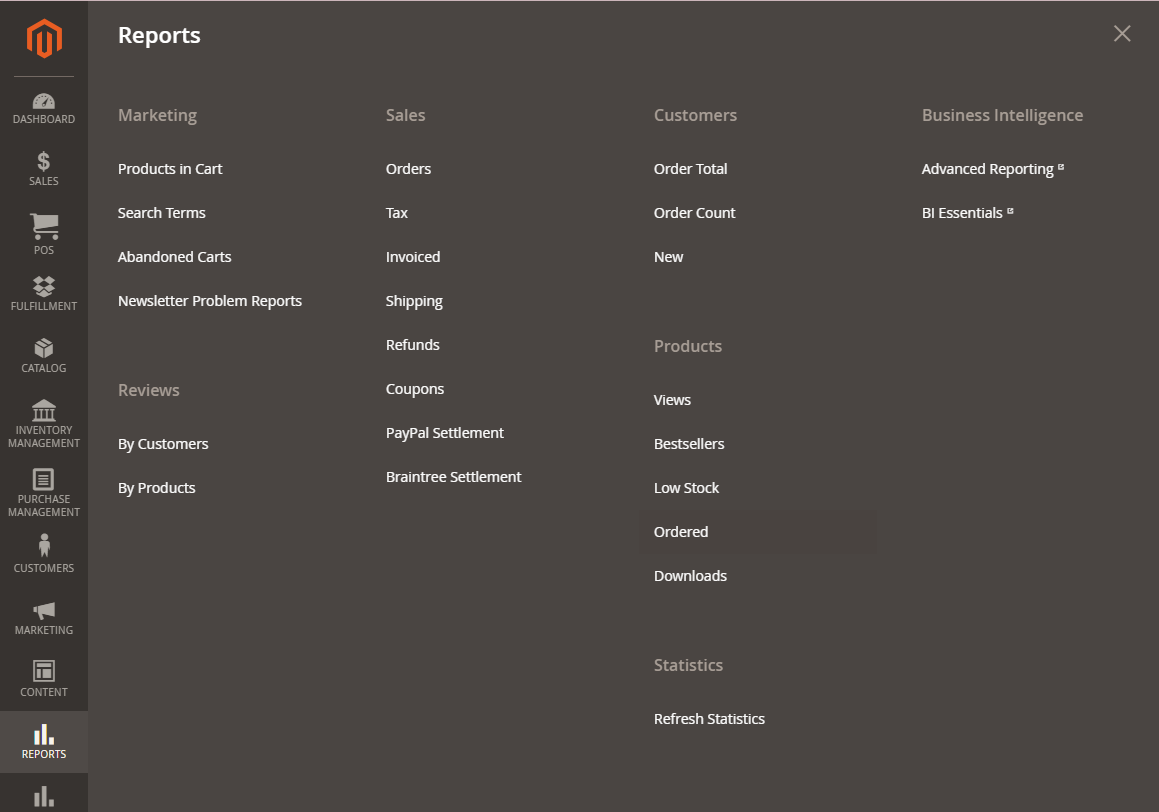
From the PrestaShop standpoint, the Stats Dashboard offers basic insights of your store performance in 8 sections:
- Overview of key metrics for a selected period: Visitors, new registrations, orders, items sold, registration and order conversion rates, and revenue
- Conversion: Value of visitors and registered customers based on the number of orders they place
- Payment distribution: The most popular payment methods chosen by customers
- Category distribution: Product count, sales, percentage of total products sold, percentage of total sales, and average product price
- Language distribution: Preferred language by customers when browsing your site
- Zone distribution: Registered customers and sales by zone
- Currency distribution: The most commonly used currencies by customers
- Attribute distribution: To see which product attributes and attribute groups are most frequently used.
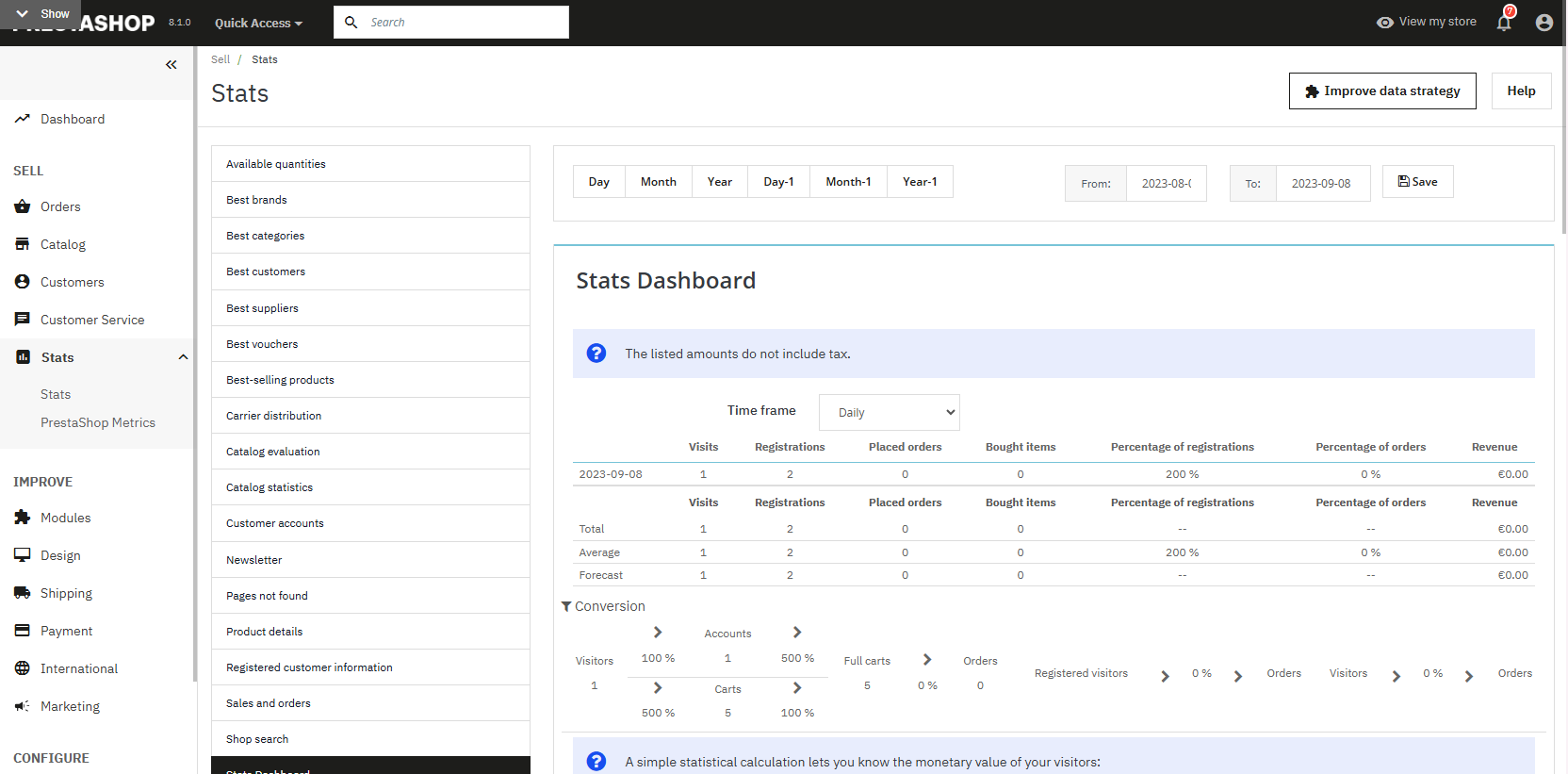
Moreover, you can navigate to the right corner for key metrics:
- Marketing: Best brands, best categories, best vouchers, newsletter and shop search
- Sales: Best-selling products, sales and orders
- Customers: Best customers, customer accounts, and registered customer information
- Products: Available quantities, best suppliers, carrier distribution, catalog evaluation, catalog statistics, product details, pages not found
Yet PrestaShop doesn’t organize reports into clear categories, making it harder for users to find relevant insights for specific business areas quickly.
Overall, Magento stands out by offering a wide range of detailed reports and easy-to-use filters to adjust data. And if you upgrade to Adobe Commerce, you get even more powerful features. In contrast, PrestaShop, while covering the basics, lacks well-structured and in-depth reporting, causing users to go back and forth for needed information.
Winner: Magento.
SEO and marketing
In general, Magento and PrestaShop support you with some basic features and integrations:
- Search Engine Optimization (SEO)
- Sitemap to index your website pages and images more efficiently
- URL rewrites to replace complex and unreadable links
- Canonical tags to avoid duplicate content and improve rankings
- Page title, meta description, and snippets to improve indexing
- Marketing:
- Google Ads integration:
- Create and manage Google Ads campaigns directly from PrestaShop backend
- Track conversions like ad clicks in the Magento backend
- Newsletters for stronger customer relationships
- Google Ads integration:
- Promotions:
- Apply special offers by location, category, customer group, or product
- Distribute flexible coupons online and offline
- Support multi-tier pricing for quantity-based discounts
- Free shipping
While Magento Open Source serves as a solid starting point, Adobe Commerce opens up a suite of advanced tools that can truly take your efforts to the next level:
- Customer attribute management
- Automated email marketing reminder
- Google tag manager
- Customer segmentation
- Solr Search
- Content Management System
- Monitor and report coupon activity
- Automate reminders and coupons for abandoned carts and wish lists
- Implement multi-tier pricing for bulk discounts
- Enforce Minimum Advertised Price (MAP)
- Integrated Google tools: privacy settings, analytics, content experiments, tag manager, and Adwords
On the other hand, PrestaShop offered fewer built-in modules for marketing and social networking including:
- Cross-selling
- Product comments
- Buy button lite
- Social media follow links
- Social media share buttons
- Send gifts
PrestaShop Marketing module helps you sync data with Google Merchant Center and promote your products across Google channels with pricing starting at €14,99.
All in all, PrestaShop falls behind its peers due to its lack of advanced promotional tools, less suited for businesses with complex promotional needs.
Winner: Magento.
Themes
First impressions are everything when it comes to attracting customers, which is why businesses work hard to ensure their storefronts look appealing.
On that note, both platforms give you the flexibility to choose and customize a variety of free and paid themes. While Magento provides over 300 themes and templates, PrestaShop takes it up a notch with more than 2,000 options. These themes are available on the Commerce Marketplace, PrestaShop Addons Marketplace, and other external providers such as Themeforest.
One plus point of PrestaShop is that you come across its themes and templates in different categories of styles, business sectors, premium features, and email design needs. This helps you quickly find the ideal layout to deliver a positive user experience.
Winner: PrestaShop.
Inventory management
It’s essential to take control of your stock to reduce operational costs and satisfy your customers.
Both Magento Open Source and PrestaShop come with the basics you’d expect for inventory management:
- Support managing single and multiple inventory sources
- Provide real-time visibility into product inventory across multiple warehouses and locations
- Easily manage back-ordered items
- Indicate available sale quantities
- Customize out-of-stock messaging and display stock availability
- Set the minimum sale quantity per order
- Set low stock alerts and send notifications
That said, Magento Open Source takes it a step further with some additional features, including:
- Track aggregated stock quantities from assigned sources
- Ensure concurrent checkout protection
- Match shipments using algorithms
And if your business is handling a large number of SKUs, Adobe Commerce is the go-to choice, offering even more advanced tools:
- Capture inventory snapshots indicating available SKUs per source node, along with a historical quantity log that tracks changes
- Set unlimited stock by SKU or source for constant availability
- Report in-flight stock that cannot be sold online
- Configure source node info including name, ID, location, safety stock, contact, timezone, coordinates, services, and shipping methods.
Winner: Magento.
B2B functionality
Though you could use plugins and extensions from both marketplaces to address your B2B needs, it’s worth taking into account the out-of-the-box B2B features of each platform.
To begin with, Magento Open Source itself doesn’t include B2B functionality by default since it primarily focuses on B2C. For businesses in need of robust Magento B2B capabilities, Adobe Commerce surpasses with features like:
- Manage accounts, purchases, quotes, and credit independently with self-service tools
- Allow multiple company buyers with roles and permissions
- Set custom catalogs and pricing for contract terms
- Streamline quote and pricing management with an online workflow
- Enable customers to reorder quickly from past purchases
- Support orders up to 300 line items
Meanwhile, for PrestaShop B2B functionality, you must activate the B2B mode and then adjust your customer profiles with details, such as company name, web address, authorized credit, payment terms, and risk assessment. At this point, your customers will be treated as companies rather than individual buyers, which in turn opens up new features, including:
- Mask prices for specific customer groups
- Manage prices for customers across the entire catalog or certain categories
- Generate invoices manually
As we can see, Magento delivers a much more well-rounded B2B solution. Although PrestaShop does have a B2B mode, it primarily focuses on basic features. Additionally, PrestaShop’s B2B setup functions more like a quick “pop-up mode”, lacking the depth of customization compared to Magento.
Winner: Magento.
Pricing
To compare Magento vs Prestashop pricing, we outline the key components below:
PrestaShop | Magento Open Source | Adobe Commerce | |
License cost | $0 | $0 | $22,000–$125,000/year |
Hosting | $1–$200/month | $2–$800/month | $2–$800/month |
Domain name | $10–$15/year | $10–$400/year | $10–$400/year |
SSL/TLS | $5–$1,000/year | $50–300/year | $50–$300/year |
Modules and extensions | $0–$600/module | $0–$60,000/extension | $0–$60,000/extension |
Themes | $60–$200 | $0–$500 | $0–$500 |
Development time | Depends | Depends | Depends |
Customization | Depends | Depends | Depends |
Maintenance | $150–$300/month | $50–$100/hour | $50–$100/hour |
Total | $300–$2,300 | $100–$60,000 | $22,000–$180,000 |
Learn more about Magento pricing: The true cost of running a Magento website
Winner: PrestaShop.
Multi-lingual and multi-currency support
Up to this point, both platforms support international eCommerce, which means multi-lingual and multi-currency functionalities are available to help you reach global audiences.
For Magento, you can set up each store view to support a different language and configure translations by installing a language pack.
PrestaShop platform makes it just as easy to go global. It’s possible to add a language manually or use localization packs that include translations for the basics, such as product sheets, categories, and SEO tags.
In terms of multi-currency support, Magento highlights options for over 200 countries.
Winner: It’s a draw.
Technical support
Speaking of Magento Open Source, users primarily rely on community support. With a forum of nearly 500,000 members, there’s a wealth of information including tips, tricks, and experiences at your fingertips. Since there’s no official support, you can work with third-party service providers for assistance. In contrast, Adobe Commerce users have the upper hand through service plans and best practice guides for installation, configuration, maintenance, and troubleshooting.
About PrestaShop, you can easily access free documentation and tutorials through the Help Center and Forum. If your business has a larger budget, consider paid support plans and tickets starting at €50 to cover various needs, such as installation, configuration, optimization, and technical issues.
Winner: It’s a draw.
Extensions
To run a store successfully, you may need high-level capabilities rather than just basic ones. This is where extensions come in handy.
Commerce Marketplace is known as a strong competitor in terms of variety and depth to support complex operations. Here you’ll have various choices among approximately 5,000 paid and unpaid Magento extensions from many top providers, such as BSS Commerce and Amasty.
There are 6 main segments to improve your customer, payment, marketing, finance, shipping, and site management. Nevertheless, the premium extensions can cost up to $99,999. Plus, due to the inherent technical nature, you might need to hire developers to install and configure the addons smoothly.
You might like: 9 best free and paid blog extensions for Magento 2 (2025).
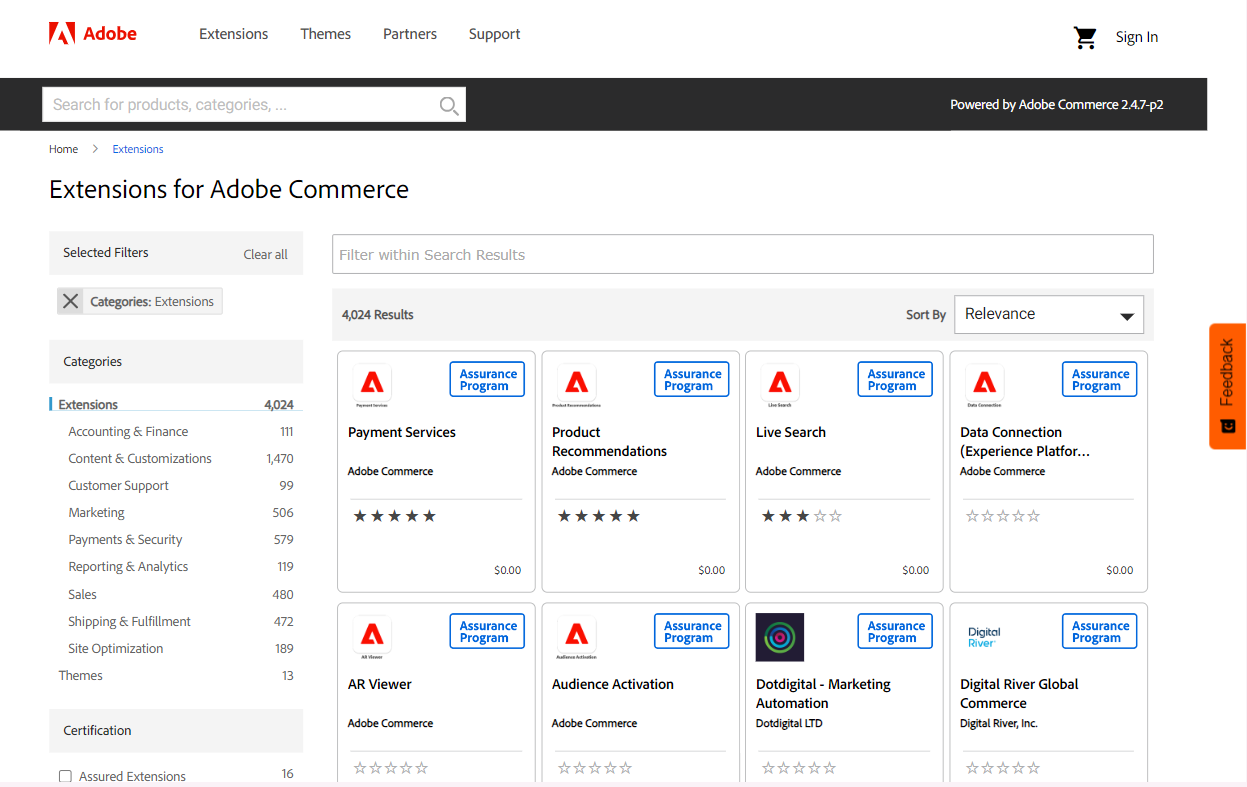
On the other hand, PrestaShop Marketplace comes with 4,000 modules with different objectives and features. Many of these are available in free download and 14-day free trial plan. The price is also more affordable up to €629,99.
Another strength of PrestaShop lies in over 2,000 theme options, 400 times more than its rival. Unlike Magento, PrestaShop’s user-friendly interface allows you to navigate and install with just a few clicks. Nevertheless, some users have reported concerns regarding out-of-date templates and a lack of advanced plugins for data analysis and reporting, which may limit capabilities compared to other platforms.
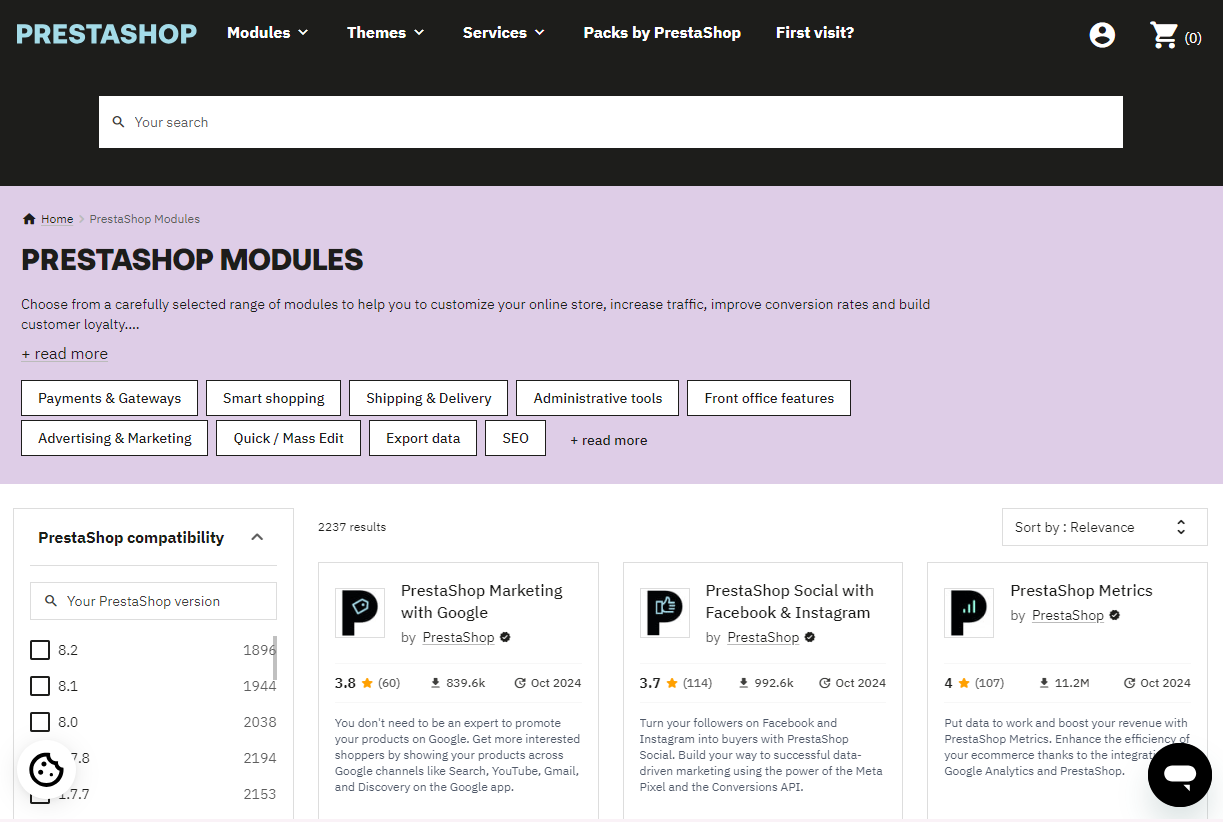
Winner: Magento.
Magento vs PrestaShop: Pros and cons
To select the best match for your business between Magento vs Prestashop, it’s crucial to understand unique selling points and aspects of concern. Below is our collection:
Magento | PrestaShop | |
Pros |
|
|
Cons |
|
|
Which eCommerce platform is best for you: Magento or PrestaShop?
Although both eCommerce platforms are popular and offer great solutions for businesses, it does not mean that you can choose them at will. To answer this question, we analyze three criteria as follows.
Business size and budget
- Magento suits medium-to-large-scale businesses ready to make a major investment.
- PrestaShop is ideal for small-to-midsize businesses with a moderate budget.
You won’t need to pay for Magento Open Source or PrestaShop, as both allow you to set up and build an online store for free. However, the Adobe Commerce edition comes with a high price tag so it’s important to ensure your budget can cover both the licensing and ongoing maintenance costs.
Alongside that, though Magento Open Source itself is free, keep in mind that other expenses, such as hosting, extensions, and development, can add up quickly. Instead, PrestaShop offers more affordable hosting and module options, while still providing all the essential features for running your business, from payments and SEO to administration and reporting.
Therefore, if you have a tight budget and manage a smaller scale, PrestaShop is a suitable option. For businesses with larger operations requiring more robust infrastructure and support for high order volumes, Magento is a better fit.
Technical resources
- If you’ve got a strong development team, Magento is the way to go.
- Without much technical know-how, you can switch to PrestaShop.
As you can see from the pros and cons section, even a person without much technical knowledge can start with PrestaShop. Its intuitive admin interface makes it easy to use and manage, though more complex customizations and integrations may still require some help from a developer.
Magento is a completely different story. If you’re confident that you’ve got a solid in-house development team or the budget to bring in external experts, Magento’s advanced features make it a compelling choice.
Long-term growth
- Choose Magento to future-proof your business
Are you planning to keep your business on a small to medium scale with a moderate customer base in the future? PrestaShop is great when starting with limited capital thanks to the flexibility and numerous modules to customize your store. However, as your business grows and the number of orders and site traffic increases, you might find PrestaShop struggling to keep up. At that point, switching to a different eCommerce platform can become both time-consuming and costly.
This is where Magento comes in. You begin for free with the Open Source edition and then upgrade to an all-in-one solution as your business expands. With its superior architecture and features, Magento makes it easier to break into new markets and handle traffic spikes seamlessly.
Conclusion
Each platform brings unique benefits to various businesses. We hope this article has provided you with valuable insights into Magento 2 vs Prestashop, helping you make a knowledgeable decision. What are your thoughts on these platforms? If you’d like to discuss them further or need additional guidance, feel free to reach out to our experts.
Comparison with other eCommerce platforms:
FAQs
What is the difference between Magento 2 and PrestaShop 8?
While Magento 2 is the latest version of Adobe’s platform, PrestaShop 8 is the most recent release from PrestaShop. The main differences between these two shopping carts are their features, scalability, and ease of use. Although Magento 2 is feature-rich for high-volume merchants and powerful API integration, PrestaShop stands out for its ease of setup.
What is better than Magento?
Better alternatives rely on your business needs and priorities. You can consider platforms like Shopify, WooCommerce, BigCommerce, and Salesforce.
- Shopify: Best for small and medium-sized businesses looking for ease of use and fast setup.
- WooCommerce: Best for businesses wanting customization and control, especially those already using WordPress.
- BigCommerce: Ideal for growing businesses needing scalability and built-in features for large product catalogs.
- Salesforce Commerce Cloud: Suited for large enterprises needing complex, omnichannel capabilities and Salesforce ecosystem integration.
Is Magento the best eCommerce platform?
Yes, Magento is one of the best eCommerce platforms. It’s highly customizable and scalable, making it a top choice for large enterprises and businesses with complex requirements.
Learn more about 2024 Trends: How Magento’s new features drive eCommerce success.
Why is PrestaShop better?
PrestaShop is better because it’s free, user-friendly, and flexible. Its open source nature allows users to customize their stores without extensive technical skills. It’s appropriate for beginners and SMEs looking for a low-cost yet powerful eCommerce solution.
Why Magento is better?
Magento is better due to its advanced functionality, scalability, and customization. Its robust feature set includes multi-store management and support for B2B and B2C models. This helps businesses create complex workflows to handle large inventory or high-traffic volumes.
Which is best Magento or Shopify?
Shopify is the best for those looking for an easy-to-use, fully hosted solution, making it perfect for small to medium-sized units. However, if your larger business requires complexity in customizations, integrations, or extensive product catalogs, Magento would be better suited.




